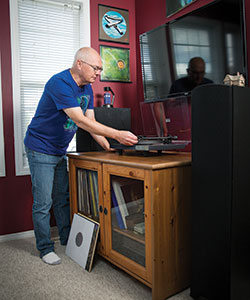A lifelong music fan, David Hewitt (Automotive Services Technician ’80) sold his turntable and record collection in the late 1980s. It was taking up a lot of space and, besides, he had the latest in audio gear: a compact disc player, which promised perfect sound forever.
But over the years, the Automotive Service Technician instructor missed listening to his favourite albums on vinyl (even the pops and crackles).
“There’s the nostalgic feeling for sure,” he says, “but there’s also something very tangible. You remove a record from its sleeve, look at the surface, make sure it’s clean. You get this whole ritual which you don’t get from a CD.”
About four years ago, Hewitt bought a turntable and began buying records again. He’s not alone. Last year vinyl sales soared 39 per cent in Canada. In the U.S., revenue from record sales reached $416 million, its highest level since 1988. Today, walk into a record store and you’ll see 20-somethings elbow-to-elbow with boomers, flipping through racks of wax.
To help the young and young-at-heart navigate the world of vinyl, Hewitt reveals his 5 secrets to record collecting.
 Buy a turntable
Buy a turntable
“This is where it all starts,” says Hewitt. You can get an entry-level turntable (some with USB for connecting to a computer) for under $200. Hewitt advises against all-in-one record players with built-in speakers that typically sell for around $100. They don’t sound
very good, he says.
Vintage turntables are another option, which can sometimes be found in thrift stores for less than $20. Factor in about $40 more for a new stylus (needle) and cartridge (the piece the stylus connects to), which tend to be worn out.
Turn on the record player in the store to make sure the platter (the round surface the record sits on) rotates. Make sure the tonearm lowers to the playing surface. Check the weight. A heavier turntable reduces vibration, which improves the sound.
Check your sound system
Many modern audio receivers aren’t compatible with turntables. Make sure yours has a phono (or phonograph) input.
The output signal of most record players is low compared to other audio devices, like CD players. The phono stage of a receiver contains a pre-amp, which boosts a signal. Hewitt’s home theatre system didn’t have a phono input, so he bought an external pre-amp for around $150. These are available at most electronics shops, starting as low as $40.
Buy good quality records
Vinyl doesn’t have to cost a fortune. Hewitt suggests visiting flea markets, thrift shops and used record shops.
Carefully examine your finds. Avoid records that are badly scratched or warped. A few surface scuffs are acceptable but scratches that penetrate the grooves will cause a “pop” when the stylus passes over them. A warped record could cause your tonearm to jump, damaging your stylus.
Dust or fingerprints can be cleaned.
For prices, Hewitt often checks past sales on eBay. Another source is discogs.com, an online music database and marketplace.
Of course, you can also buy records new – though they can be pricey. New editions of classic Pink Floyd and Led Zeppelin records, for example, can run $40, and even more for deluxe editions, which feature studio outtakes, special packaging and more.
Dust is your record’s enemy.
Keep your vinyl clean
Dust is your record’s enemy. Over time, the stylus can push the tiny particles into the grooves during playback, leading to unwanted noise. Hewitt suggests investing in a brush and cleaning solution, available as a kit at most music stores for as little as $30.
Hewitt also throws out the white paper inner sleeves that come with some records. “The paper fibres can get on your records.” He prefers using soft polyethylene-lined inner sleeves, which can be purchased at most record shops and help control static. Static can produce crackling during playback.
Take time to enjoy the music
This is what the hobby is all about.
“I listen to records every day,” says Hewitt. “Sometimes I’ll sit in the evening and listen to record after record.”
For Hewitt, it’s not only a way to unwind but also a chance to bond with two of his grown sons, Jason Schneider (Automotive Service Technician ’13), a technician with NAIT’s automotive program, and Keegan Hewitt, 18. They’re getting into the hobby themselves.
“All three of us often spend an afternoon going to the flea market and used record stores to see what we can find.”